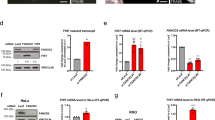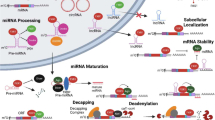Abstract
Common fragile sites (CFSs) are large genomic regions present in all individuals that are highly unstable and prone to breakage and rearrangement, especially in cancer cells with genomic instability. Eight of the 90 known CFSs have been precisely defined and five of these span genes that extend from 700 kb to over 1.5 Mb of genomic sequence. Although these genes reside within some of the most unstable chromosomal regions in the human genome, they are highly conserved evolutionarily. These genes are targets for large chromosomal deletions and rearrangements in cancer and are frequently inactivated in multiple tumor types. There is also an association between these genes and cellular responses to stress. Based upon the association between large genes and CFSs, we began to systematically test other large genes derived from chromosomal regions that were known to contain a CFS. In this study, we demonstrate that the 730 kb retinoic acid receptor-related orphan receptor alpha (RORA) gene is derived from the middle of the FRA15A (15q22.2) CFS. Although this gene is expressed in normal breast, prostate and ovarian epithelium, it is frequently inactivated in cancers that arise from these organs. RORA was previously shown to be involved in the cellular response to hypoxia and here we demonstrate changes in the amount of RORA message produced in cells exposed to a variety of different cellular stresses. Our results demonstrate that RORA is another very large CFS gene that is inactivated in multiple tumors. In addition, RORA appears to play a critical role in responses to cellular stress, lending further support to the idea that the large CFS genes function as part of a highly conserved stress response network that is uniquely susceptible to genomic instability in cancer cells.
This is a preview of subscription content, access via your institution
Access options
Subscribe to this journal
Receive 50 print issues and online access
$259.00 per year
only $5.18 per issue
Buy this article
- Purchase on Springer Link
- Instant access to full article PDF
Prices may be subject to local taxes which are calculated during checkout






Similar content being viewed by others
References
Arlt MF, Casper AM, Glover TW . (2003). Cytogenet Genome Res 100: 92–100.
Becker NA, Thorland EC, Denison SR, Phillips LA, Smith DI . (2002). Oncogene 21: 8713–8722.
Becker-Andre M, Andre E, DeLamarter JF . (1993). Biochem Biophys Res Commun 194: 1371–1379.
Bednarek AK, Keck-Waggoner CL, Daniel RL, Laflin KJ, Bergsagel PL, Kiguchi K et al. (2001). Cancer Res 61: 8068–8073.
Broussard DR, Lozano MM, Dudley JP . (2004). J Virol 78: 4943–4946.
Buttel I, Fechter A, Schwab M . (2004). Ann NY Acad Sci 1028: 14–27.
Carlberg C, Hooft van Huijsduijnen R, Staple JK, De-Lamarter JF, Becker-Andre M . (1994). Mol Endocrinol 8: 757–770.
Casper AM, Nghiem P, Arlt MF, Glover TW . (2002). Cell 111: 779–789.
Chang NS, Doherty J, Ensign A, Lewis J, Heath J, Schultz L et al. (2003). Biochem Pharmacol 66: 1347–1354.
Chauvet C, Bois-Joyeux B, Berra E, Pouyssegur J, Danan JL . (2004). Biochem J 384: 79–85.
Chauvet C, Bois-Joyeux B, Danan JL . (2002). Biochem J 364: 449–456.
Druck T, Hadaczek P, Fu TB, Ohta M, Siprashvili Z, Baffa R et al. (1997). Cancer Res 57: 504–512.
Dumon KR, Ishii H, Fong LY, Zanesi N, Fidanza V, Mancini R et al. (2001). Proc Natl Acad Sci USA 98: 3346–3351.
Dussault I, Giguere V . (1997). Mol Cell Biol 17: 1860–1867.
Finnis M, Dayan S, Hobson L, Chenevix-Trench G, Friend K, Ried K et al. (2005). Hum Mol Genet 14: 1341–1349.
Gemma A, Hagiwara K, Ke Y, Burke LM, Khan MA, Nagashima M et al. (1997). Cancer Res 57: 1435–1437.
Giguere V . (1999). Endocr Rev 20: 689–725.
Giguere V, Tini M, Flock G, Ong E, Evans RM, Otulakowski G . (1994). Genes Dev 8: 538–553.
Glover TW, Berger C, Coyle J, Echo B . (1984). Hum Genet 67: 136–142.
Gopalakrishnan VK, Banerjee AG, Vishwanatha JK . (2003). Pancreatology 3: 293–302.
Hamilton BA, Frankel WN, Kerrebrock AW, Hawkins TL, FitzHugh W, Kusumi K et al. (1996). Nature 379: 736–739.
He YW, Deftos ML, Ojala EW, Bevan MJ . (1998). Immunity 9: 797–806.
Hirose T, Smith RJ, Jetten AM . (1994). Biochem Biophys Res Commun 205: 1976–1983.
Huebner K, Garrison PN, Barnes LD, Croce CM . (1998). Annu Rev Genet 32: 7–31.
Huebner K, Hadaczek P, Siprashvili Z, Druck T, Croce CM . (1997). Biochim Biophys Acta 1332: M65–M70.
Ishii H, Mimori K, Inageta T, Murakumo Y, Vecchione A, Mori M et al. (2005). Mol Cancer Res 3: 130–138.
Jetten AM . (2004). Curr Drug Targets Inflamm Allergy 3: 395–412.
Jetten AM, Ueda E . (2002). Cell Death Differ 9: 1167–1171.
Jiang H, Ren Y, Zhao J, Feng J . (2004). Hum Mol Genet 13: 1745–1754.
Krummel KA, Denison SR, Calhoun E, Phillips LA, Smith DI . (2002). Genes Chromosomes Cancer 34: 154–167.
Laiho M, Latonen L . (2003). Ann Med 35: 391–397.
Lau P, Bailey P, Dowhan DH, Muscat GE . (1999). Nucleic Acids Res 27: 411–420.
Lee WH, Murphree AL, Benedict WF . (1984). Nature 309: 458–460.
Littman DR, Sun Z, Unutmaz D, Sunshine MJ, Petrie HT, Zou YR . (1999). Cold Spring Harb Symp Quant Biol 64: 373–381.
Ludes-Meyers JH, Bednarek AK, Popescu NC, Bedford M, Aldaz CM . (2003). Cytogenet Genome Res 100: 101–110.
Matsuyama A, Shiraishi T, Trapasso F, Kuroki T, Alder H, Mori M et al. (2003). Proc Natl Acad Sci USA 100: 14988–14993.
Matysiak-Scholze U, Nehls M . (1997). Genomics 43: 78–84.
Migita H, Satozawa N, Lin JH, Morser J, Kawai K . (2004). FEBS Lett 557: 269–274.
Missbach M, Jagher B, Sigg I, Nayeri S, Carlberg C, Wiesenberg I . (1996). J Biol Chem 271: 13515–13522.
Moretti RM, Marelli MM, Motta M, Polizzi D, Monestiroli S, Pratesi G et al. (2001). Prostate 46: 327–335.
Nau MM, Brooks Jr BJ, Carney DN, Gazdar AF, Battey JF, Sausville EA et al. (1986). Proc Natl Acad Sci USA 83: 1092–1096.
Nyberg KA, Michelson RJ, Putnam CW, Weinert TA . (2002). Annu Rev Genet 36: 617–656.
Pawlikowski M, Kunert-Radek J, Winczyk K, Melen-Mucha G, Gruszka A, Karasek M . (1999). Adv Exp Med Biol 460: 369–372.
Schrader M, Danielsson C, Wiesenberg I, Carlberg C . (1996). J Biol Chem 271: 19732–19736.
Smith DI, Huang H, Wang L . (1998). Int J Oncol 12: 187–196.
Sutherland GR, Baker E, Richards RI . (1998). Trends Genet 14: 501–506.
Sutherland GR, Richards RI . (1995). Curr Opin Genet Dev 5: 323–327.
Wang F, Denison S, Lai JP, Philips LA, Montoya D, Kock N et al. (2004). Genes Chromosomes Cancer 40: 85–96.
Author information
Authors and Affiliations
Corresponding author
Rights and permissions
About this article
Cite this article
Zhu, Y., McAvoy, S., Kuhn, R. et al. RORA, a large common fragile site gene, is involved in cellular stress response. Oncogene 25, 2901–2908 (2006). https://doi.org/10.1038/sj.onc.1209314
Received:
Revised:
Accepted:
Published:
Issue Date:
DOI: https://doi.org/10.1038/sj.onc.1209314
Keywords
This article is cited by
-
ALDOC- and ENO2- driven glucose metabolism sustains 3D tumor spheroids growth regardless of nutrient environmental conditions: a multi-omics analysis
Journal of Experimental & Clinical Cancer Research (2023)
-
Leveraging pleiotropic association using sparse group variable selection in genomics data
BMC Medical Research Methodology (2022)
-
Illuminating links between cis-regulators and trans-acting variants in the human prefrontal cortex
Genome Medicine (2022)
-
Circadian rhythms and cancers: the intrinsic links and therapeutic potentials
Journal of Hematology & Oncology (2022)
-
RORA alleviates LPS-induced apoptosis of renal epithelial cells by promoting PGC-1α transcription
Clinical and Experimental Nephrology (2022)



